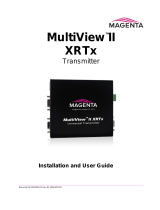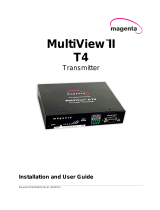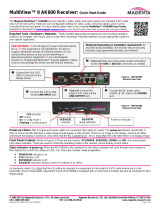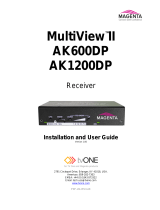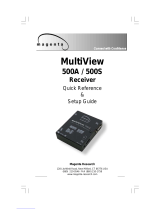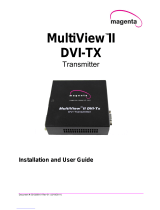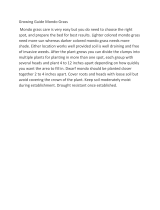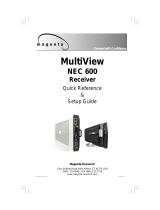Page is loading ...

.
1
Mondo III Matrix
Installation
&
Setup Guide

2
MAGENTA MONDO MATRIX
© 1998-2011 by Magenta Research All rights reserved.
Magenta Research
128 Litchfield Road
New Milford, CT 06776 USA
This document and the Magenta Research products to which it relates, and the copyright in each, is the property of
Magenta Research. Neither the document nor the products may be reproduced by any means, in whole or in part, without
the prior written permission of Magenta Research. Magenta Research makes no warranty or representation, either
express or implied, with respect to this software or documentation, including their quality, performance, merchantability,
or fitness for a particular purpose. As a result, this software or documentation are licensed "as is" and you, the licensee,
are assuming the entire risk as to their quality and performance.
In no event will Magenta Research be liable for direct, indirect, special, incidental, or consequential damages arising out
of the use of or inability to use the software or documentation.
Magenta Research and the Magenta Research logo are trademarks of Magenta Research.
All other brands, product names, and trademarks are the property of their respective owners.

.
3
1
FEDERAL COMMUNICATIONS COMMISSION AND INDUSTRY CANADA
RADIO FREQUENCY INTERFERENCE STATEMENTS
This device complies with part 15 of the FCC Rules. Operation is subject to the following two conditions: 1) This
device may not cause harmful interference, and
(2) this device must accept any interference received, including interference that may cause
undesired operation.
This equipment has been tested and found to comply with the limits for a Class A digital device, pursuant to part 15
of the FCC Rules. These limits are designed to provide reasonable protection against harmful interference when the
equipment is operated in a commercial environment. This equipment generates, uses, and can radiate radio
frequency energy and, if not installed and used in accordance with the instruction manual, may cause harmful
interference to radio communications. Operation of this equipment in a residential area is likely to cause harmful
interference in which case the user will be required to correct the interference at his own expense.
Canada (ICES-003) notice: This Class A digital apparatus complies with Canadian ICES-003.
Cet appareil numerique de la classe A est conforme a la norme NMB-003 du Canada.
EUROPEAN UNION DECLARATION OF CONFORMITY
Warning: This is a Class A product. In a domestic environment this product may cause radio
interference in which case the user may be required to take adequate measures.
Magenta Research (New Milford CT USA) declares under our sole responsibility that the product Mondo III System
to which this declaration relates is in conformity with the following standard(s) or other normative documents:
EN 55022:1998/A1:2000/A2:2003 Class A ITE emissions requirements (EU AS/NZS).
EN61000-3-2:2006 Limits for harmonic current emissions (equipment input current up to
and including 16A per phase).
EN 61000-3-3:1995/A1:2001/A2:2005 Limitation of voltage fluctuations and flicker on low-
voltage supply systems for equipment with rated current up to and including 16A.
EN60950-1:2006 Safety for Information Technology Equipment
EN55024:1998/A1:2001/A2:2003 Immunity for ITE
SAFETY WARNING
Installation • This equipment is to be installed in a restricted access location.
Connection • Not for direct connection to Telecommunication Network Circuitry (TNV)
Power sources • This equipment should be operated only from the power source indicated on the product. This
equipment is intended to be used with a main power system with a grounded (neutral) conductor. The
third (grounding) pin is a safety feature, do not attempt to bypass or disable it.
This equipment can be powered from redundant power sources. Disconnect all power sources before servicing.
Power disconnection • To remove power from the equipment safely, remove all power cords from the rear of
the equipment, or from the power source receptacle (wall plug). Note that this equipment has multiple power inputs.
Power cord protection • Power cords should be routed so that they are not likely to be stepped on or pinched by
items placed upon or against them.
Servicing • Refer all servicing to qualified service personnel. There are no user-serviceable parts inside. To
prevent the risk of shock, do not attempt to service this equipment yourself because opening or removing
covers may expose you to dangerous voltage or other hazards.
Slots and openings • If the equipment has slots or holes in the enclosure, these are provided to prevent
overheating of sensitive components inside. These openings must never be blocked by other objects.
Lithium battery • There is a danger of explosion if battery is incorrectly replaced. Replace it only with the
same or equivalent type recommended by the manufacturer. Dispose of used batteries according to local laws.
The battery stores configuration information in the event of a power failure. Contact manufacturer for battery
replacement procedures. Battery is not intended to be a user serviceable part
FCC/IC RFI STATEMENTS, EU DECLARATION OF CONFORMIT, SAFETY WARNING.

4
MAGENTA MONDO MATRIX
Contents
Chapter Page
1. Specifications............................…...................................................................3
2. Overview & Design Guidelines….......….........................................................4
3. Installation…………........................................… ......................................….14
4. Configuration………........................................… ......................................….18
5. Commands.........................................................................................……....21
6. Mondo III SAP Design, Configuration, Usage....................................……....32
7. Troubleshooting…………………………………………………………………....35
Appendix A: Cable Pinouts..…………………………………………………………...36
Appendix B: Fan Filter Cleaning/Replacement……………………………………...39
Appendix C: Using the USB port on Mondo III SAP………………………………...40
2

.
5
CHAPTER 1: Specifications
1 Specifications
Video & Aux Signals:
Signal configuration………………………4 , individually routable channels per RJ-45 jack.
Input impedance.....................................100Ω balanced (Compatible with all MultiView equipment)
Nominal input amplitude.........................1 Volt P-P
Dynamic headroom ................................>3dB
Gain from transmitter input to receiver
output through switch ...…………………Unity
Coupling from transmitter input to
receiver output....…………………………DC
Circuitry bandwidth .................................>220MHz
Signal type ..............................................1,2,3,4 & 5 component video + aux channels (Via MultiView components)
Input connectors (UTP)............................RJ-45 Female
Input connectors (VGA)...........................HD15 female, 1/8” audio socket
Loop out connectors.........................…....RJ-45 Female
Output connectors…………………………RJ-45 female
Audio:
Audio signals are ported into the Mondo III Matrix via MutiView components or via a 3.5mm stereo audio jack for Mondo Direct.
The type of transmitters and receivers used therefore defines audio specifications. Please refer to the spec sheets for those
components.
RS 232 Serial:
Serial signals are ported into the Mondo III Matrix via MultiView components or via a 3.5mm audio jack for simplex transmit in a
Mondo Direct. Transmission is uni-directional broadcast in this mode.
Mondo III SAP versions allow bi-directional serial sessions with individual receivers. There are 8 DB9 COM ports on each Mondo
III SAP frame That can be used in conjunction with SAP enabled receivers for full bi-directional RS232 communication with the
device attached to the receiver. Reference Section 6 for SAP usage.
Control:
Protocol to switch…………………………RS-232/RS-422*, Selectable; 9600 baud standard,
(rate selectable to 9600, 19,200, 38,400, 57,600, 115,200)
8 data bits, 1 stop bit, no parity, no flow control.
Interface connector, input………….….….DB9 or 7 position Phoenix**
Interface connector, input………….….….USB mini B type (Mondo III SAP ONLY. Requires driver file: MONDO3_USB.inf)
Interface connector,
Interframe communication, input/output………...3 position Phoenix or 7 position Phoenix (used for Mondo Legacy mode only)***
All input to output switching commands are received and processed by the master frame. Additional frames used within the matrix
are connected in a daisy chain and receive processed commands from the master frame.
In Mondo III serial control mode, the BUS terminator switch must be ON for the first and last frames.
* The 7 pin phoenix serial input supports both RS-232 and RS-422 modes
The DB9 serial ports support RS-232 only
** When using Mondo III frames in a legacy Mondo system only the 7 pin phoenix serial connections are used.
*** The BUS connector and DB9 ports are disabled in this mode.
Power:
Power input .............................................100-240V / 50~60Hz
Fused input. Replace fuse with same rating: 250V, 2.5A, Slow Blow, 5x20mm
Consumption……………………………….200 W Max
Redundancy………………………………..2 independent fully redundant AC Mains inputs.
Environmental:
Temperature/humidity
Storage ………………………………...….-40° to +158°F (-40° to +70°C) / 10% to 90%, non-condensing
Operating...........................………………...0° to +104°F (0° to +40°C) / 10% to 90%, non-condensing
Mechanical:
Rack mount ................................……..…Standard, 4U 19” EIA
Enclosure type ..........................…………Front Panel: Powder coat over aluminum
Enclosure: Aluminum
Enclosure dimensions ......………………..7.0" H x 19" W x 10.25" D (178 mm H x 483 mm W x 260 mm D)
Weight ................................…….………..16.6 lbs (7.5 kg) fully populated (shipping weight: 24 lbs (10.9 kg))
Compliances .............................…………CE, NRTL Listed, FCC Part 15
MTBF ......................................……….….100,000 hours
3

6
MAGENTA MONDO MATRIX
2. Overview / Design Guidelines
2.1 OverView
The Mondo III Matrix CAT5 routing switch is a full matrix platform to easily distribute and route video, audio , and
serial signals using the MultiView series of video over Cat5 products. It is available in configurations ranging from 16
inputs to 16 outputs up to 256 inputs to 512 outputs.
New features of the Mondo III architecture are the following:
Two independent AC Mains inputs for redundancy
Filtered air cooling
Improved serial communication
Status indicators on the Front Panel
Multiple serial port control
SAP capability supported in Mondo III SAP versions for end-to-end bi-directional RS232 control of displays.
Backwards compatibility with previous Mondo versions (not all features supported in legacy mode)
NOTE: This manual covers the current release of the Mondo III Matrix switch. Previous versions of the
Mondo matrix switch hardware are covered in previous user manuals. In order to utilize a Mondo III frame in
a non-Mondo III environment see Section 4, Operational Mode command and Appendix A for legacy Mondo
serial bus cabling. Contact Magenta Research for details.
The Mondo Direct option allows a direct video connection (15HD VGA) into the Mondo Matrix without using a
MultiView transmitter. An 1/8” stereo audio jack is available for audio inputs. This jack can also be configured for
transmit only serial or SPDIF digital audio at time of purchase. RJ45 cascade loop throughs provide connections to
subsequent slave frames. It is only required to have the Mondo Direct option on the first input frame. A maximum of
32 Mondo Direct inputs can be configured. It is possible to mix one Mondo Direct card and one or two standard
Mondo RJ45 input cards as well.
The Mondo III SAP version features up to 8 built-in RS 232 serial ports per frame that allow communication to SAP
enabled MultiView receiver units.
The Mondo III is controlled via an RS 232 interface either through a simple terminal program or any third party
control systems.
There are no manual or front panel control options for the Mondo III Matrix.
An optional separate touch screen interface, Mondo TC, is also available. Contact Magenta Research for details.
4

.
7
CHAPTER 2: Overview/Design Guidelines
2.2 Design Guidelines
When designing or installing a Mondo III system, the following should be adhered to:
Equalize all Cat5 Input Cables to the Mondo III Matrix
All Cat5 cable inputs should be as equal as possible between source transmitter and Mondo III Matrix switch
(This does not apply to Mondo Direct inputs with VGA inputs).
Otherwise video quality may be affected when switching as cable compensation settings at the receiver will
change due to cable lengths changing.
This can be accomplished by measuring all Cat5 cables and ensuring they are within 30 ft (9m) of variance. Add
service loops as necessary.
Another option is to use the MorphIT Dual EQ option between the transmitter and switch input to normalize all
cables to 0 ft prior to the switch. Contact Magenta for details.
5
All Cat5 Cable lengths from source Transmitters to the Mondo III Input frame
must be within a 30 ft (9m) variance. Add service loops as necessary.
Use the MorphIT Dual EQ card to remove cable lengths from source transmitter
just prior to the Mondo III Matrix switch input. Each port on the Dual EQ card can
remove 500 ft (152m) of cable length. Two ports may be cascaded to remove a
maximum of 800 ft (244m) of cable length.
Cable Length L
Cable Length = Zero ft
Cable Length Equalization Method 1: Normalize input cable lengths
Cable Length Equalization Method 2: Using Morph IT Dual EQ card

8
MAGENTA MONDO MATRIX CHAPTER 2: Introduction
2.2 Design Guidelines, cont.
Mondo III Matrix Sizing
Mondo III Matrix frames are available in 16 output sizes. Inputs may vary from 1 to 64 in 16 port increments.
To add outputs, frames are cascaded “vertically” in “rows”.
To add inputs beyond the 64 input single frame limit, frames are cascaded “horizontally” in “columns”.
In the case of Mondo Direct frames, a maximum of 32 inputs is allowed.
All frames must have the same number of input ports within a system.
6
Inputs 1-16
Inputs 17-32
Inputs 33-48
Inputs 49-64
Outputs
1-16
Outputs
17-32
Inputs 1-16
Inputs 17-32
Inputs 33-48
Inputs 49-64
Outputs
1-16
Outputs
17-32
Inputs 65-80
Inputs 81-96
Inputs 97-112
Outputs
1-16
Outputs
17-32
A 64 input by 16
output single frame
matrix switch
Add 16 outputs by
cascading vertically
in rows. The above
switch is now a 64
input by 32 output
two frame matrix
switch. A maximum
of 512 outputs are
possible.
Add 16 to 48 inputs
by cascading
horizontally in
columns. The above
switch is now a 112
input by 32 output 4
frame matrix switch.
A maximum of 256
inputs are possible.
Inputs 1-16
Inputs 17-32
Inputs 33-48
Inputs 49-64
Outputs
1-16

.
9
CHAPTER 2: Overview/Design Guidelines
2.2 Design Guidelines, cont.
Eight Frame Cascade Limit
All inputs to the Mondo III are cascaded to subsequent frames via Cat5 cascade loop throughs on each input
card.
It is recommended to loop through no more than 8 frames or video performance may be affected beyond 8
frames.
If using more than 8 frames, the source signals must be split using multiple transmitters, cascading transmitters
via the local monitor output frames, using T4 multi output transmitters, or the MultiView 9D Cat5 distribution
amplifier.
7
8 Frames
8 Frames
Using two single port transmitters to split the video via the local monitor port of the first transmitter:
Using a T4 transmitter to feed input video to 8 frames at a time:
8 Frames
8 Frames
UTP UTP
Video
In
Video out of local monitor port to input of second transmitter
UTP
Video
In
UTP

10
MAGENTA MONDO MATRIX CHAPTER 2: Introduction
2.2 Design Guidelines, cont.
Frame Addressing is Important
All control of the Mondo III is input via the Master frame.
In the Mondo III architecture, any frame can be configured to be the Master regardless of its address, but it is
recommended to make the first frame addressed 00 to be the master. Master frames are set via the LCD. See
Section 4 for details.
There can only be one Master frame in a system.
The Mondo III master frame intelligently configures itself when powered on by locating all other slave frames
and based on a specific addresses can route switch commands to the correct frame. The master frame should
be powered on last for this to occur.
There is no need to configure the Mondo III beyond setting frame addresses if default serial port settings are
used. If other serial port settings need to be configured or if using other serial input ports, please configure them
according to instructions in Section 4.
Please follow Table 1 on page 9 for address guidelines.
Frame addressing is done via the LCD on the rear of the frame. See Section 4 for details.
It is necessary to power cycle the frame to make the address change go into effect.
The master frame also requires to be re-initialized when a slave frame address is changed or added. This can
be accomplished using the #I command or a power reset.
Following are some examples of frame addressing based on specific Mondo III Matrix sizes.
8
Inputs 1-16
Inputs 17-32
Inputs 33-48
Inputs 49-64
Outputs
1-16
Outputs
17-32
Inputs 1-16
Inputs 17-32
Inputs 33-48
Inputs 49-64
Outputs
1-16
Outputs
17-32
Inputs 65-80
Inputs 81-96
Inputs 97-112
Outputs
1-16
Outputs
17-32
64 input by 16 output
single frame matrix
switch.
1 Row and 1 Column
Inputs 1-16
Inputs 17-32
Inputs 33-48
Inputs 49-64
Outputs
1-16
Frame Address
00
Frame Address
00
Frame Address
01
Frame Address
00
Frame Address
01
Frame Address
32
Frame Address
33
64 input by 32 output
two frame matrix
switch.
2 Rows and 1
Column
112 input by 32
output four frame
matrix switch.
Note address
sequence in
second column.
2 Rows and 2
Columns

.
11
CHAPTER 2: Overview/Design Guidelines
2.2 Design Guidelines, cont.
Use the following table to determine the correct address assignments and Input Output connections for each
switch frame. Note that Mondo III addressing has changed from legacy Mondo systems. For legacy Mondo
frame addressing, refer to previous Mondo Matrix user guides.
Table 1: Mondo III Matrix Frame Addresses
9
COL1: COL 2: COL 3: COL 4: COL 5:
INPUT
1- 64
INPUT
65 - 112
INPUT
113 - 160
INPUT
161 - 208
INPUT
209 - 256
ROW 1: Addr 00 Addr 32 Addr 64 Addr 96 Addr 128 1 - 16
ROW 2: Addr 01 Addr 33 Addr 65 Addr 97 Addr 129 17 - 32
ROW 3: Addr 02 Addr 34 Addr 66 Addr 98 Addr 130 33 - 48
ROW 4: Addr 03 Addr 35 Addr 67 Addr 99 Addr 131 49 - 64
ROW 5: Addr 04 Addr 36 Addr 68 Addr 100 Addr 132 65 - 80
ROW 6: Addr 05 Addr 37 Addr 69 Addr 101 Addr 133 81 - 96
ROW 7: Addr 06 Addr 38 Addr 70 Addr 102 Addr 134 97 - 112
ROW 8: Addr 07 Addr 39 Addr 71 Addr 103 Addr 135 113 - 128
ROW 9: Addr 08 Addr 40 Addr 72 Addr 104 Addr 136 129 - 144
ROW 10: Addr 09 Addr 41 Addr 73 Addr 105 Addr 137 145 - 160
ROW 11: Addr 10 Addr 42 Addr 74 Addr 106 Addr 138 161 - 176
ROW 12: Addr 11 Addr 43 Addr 75 Addr 107 Addr 139 177 - 192
ROW 13: Addr 12 Addr 44 Addr 76 Addr 108 Addr 140 193 - 208
ROW 14: Addr 13 Addr 45 Addr 77 Addr 109 Addr 141 209 - 224
ROW 15: Addr 14 Addr 46 Addr 78 Addr 110 Addr 142 225 - 240
ROW 16: Addr 15 Addr 47 Addr 79 Addr 111 Addr 143 241 - 256
ROW 17: Addr 16 Addr 48 Addr 80 Addr 112 Addr 144 257 - 272
ROW 18: Addr 17 Addr 49 Addr 81 Addr 113 Addr 145 273 - 288
ROW 19: Addr 18 Addr 50 Addr 82 Addr 114 Addr 146 289 - 304
ROW 20: Addr 19 Addr 51 Addr 83 Addr 115 Addr 147 305 - 320
ROW 21: Addr 20 Addr 52 Addr 84 Addr 116 Addr 148 321 - 336
ROW 22: Addr 21 Addr 53 Addr 85 Addr 117 Addr 149 337 - 352
ROW 23: Addr 22 Addr 54 Addr 86 Addr 118 Addr 150 353 - 368
ROW 24: Addr 23 Addr 55 Addr 87 Addr 119 Addr 151 369 - 384
ROW 25: Addr 24 Addr 56 Addr 88 Addr 120 Addr 152 385 - 400
ROW 26: Addr 25 Addr 57 Addr 89 Addr 121 Addr 153 401 - 416
ROW 27: Addr 26 Addr 58 Addr 90 Addr 122 Addr 154 417 - 432
ROW 28: Addr 27 Addr 59 Addr 91 Addr 123 Addr 155 433 - 448
ROW 29: Addr 28 Addr 60 Addr 92 Addr 124 Addr 156 449 - 464
ROW 30: Addr 29 Addr 61 Addr 93 Addr 125 Addr 157 465 - 480
ROW 31: Addr 30 Addr 62 Addr 94 Addr 126 Addr 158 481 - 496
ROW 32: Addr 31 Addr 63 Addr 95 Addr 127 Addr 159 497 - 512
OUTPUTS

12
MAGENTA MONDO MATRIX
2.2 Design Guidelines, cont.
Switching Individual Signals (Pairs) on a single input/output
It is possible to switch individual pairs of the Cat5 switch inputs and outputs to one or different locations.
This is useful when sending audio or serial signals from one source to locations that have different video sources.
For example, a different source of video may be displayed while a single audio or serial signal is broadcast to one or
more displays without changing the video signal. Reference the Batch Routing Command set in Section 5.
See the table below for a reference chart for the signals MultiView places on individual pairs.
Local Breakout of Signals
It is possible to breakout source input signals such as video, audio, or serial by utilizing the last input card cascade
loop outs to the appropriate Magenta receiver. Note that these signals do not pass through the switch.
10
Video Out
Audio/Serial Out

.
13
CHAPTER 2: Overview/Design Guidelines
2.2 Design Guidelines, cont.
Mondo III SAP Mode
The Mondo III SAP option features up to 8 serial ports that can be configured as Mondo control ports or used in
SAP mode.
SAP mode offers the ability for bi-directional RS232 control of devices attached to SAP enabled receiver units.
Reference Section 6, SAP Usage, for instructions on using SAP mode with the Mondo III Matrix.
The Mondo III SAP option also features an additional USB control input that can be used with any serial terminal
application on a PC. A software driver, MONDO3_USB.inf, is required to be installed on the host PC.
This can be found on the accompanying CDROM or downloaded at http://www.magenta-research.com
See diagram below for an explanation of the Mondo III serial ports.
Non-Mondo III SAP systems do not have COM3—COM8 enabled and do not have the ability for SAP control or
USB control.
11
Mondo III SAP RS232 Inputs
Com1 through Com8
Control or SAP capable
Mondo III Control
SAP version
only.
Requires software
driver on host PC

14
MAGENTA MONDO MATRIX CHAPTER 2: Overview/Design Guidelines
2.2 Design Guidelines, cont.
Controlling the Mondo III Matrix
The Mondo III Matrix does not offer manual or front panel control options.
All commands are input via an RS232 serial port on the master frame via a third party control system such as
Calypso Control Systems, Crestron, or AMX.
A remote control panel, the Mondo TC touchscreen, is also available as a control option. Contact Magenta
Research for details.
Additionally a simple terminal program such as Hyperterminal (available as part of the Windows operating system)
may be used to send individual commands to the Mondo III.
The Mondo III features multiple serial ports for various control options depending upon the version:
Mondo III without the SAP option
Features two DB9 COM ports that can be used for additional control options (note that ports COM1
and COM2 are only supplied on the first Mondo frame).
The 7 pin phoenix connector labeled 1-7 may also be used as a control input COM port.
Mondo III with the SAP option
Features eight DB9 COM ports that can be used for additional control options or in SAP mode.
The 7 pin phoenix connector labeled 1-7 may also be used as a control input COM port.
A USB port can also be used with a PC serial terminal application.
Interframe serial cabling utilizes the BUS connector labeled A,B, GND. This is a high speed serial bus system that
has higher execution speeds. This bus is only compatible in Mondo III mode.
A 7 pin phoenix output connector labeled 8-14 is provided for backwards compatibility with older Mondo systems.
The Mondo III frame must be configured via the LCD to legacy mode for this connector to function.
See Appendix A for cabling and Section 4 for LCD configuration.
See Section 3 for cabling and connection diagrams.
12
Mondo III Interframe cabling (input)
Mondo III Control Input and/or
Legacy Mondo Interframe
Cabling (input)
Legacy Mondo Interframe
Cabling (output)
Not used for Mondo III
Mondo III Interframe Bus Termination switch.
Mondo III Interframe cabling (output)
Mondo III Control
SAP version
only.
Requires software
driver on host PC
Contact Closure
Used in ALARM
mode. See
command section
Mondo III Control Input (COM1 &
COM2.
Non-SAP versions. First frame only
Mondo III Control Input (COM1
through COM8.
SAP versions. All frames.

.
15 13
2.2 Design Guidelines, cont.
Front Panel Status Dashboard
Each Mondo III frame features a front panel status panel that shows a frames current state with respect to power
supply health, fan health, air filter service, internal frame temperature, system communications, and any alarm
events.
Indicators are detailed and explained below:
PS1/PS2 – Power supply status indicator. The power supply generates two voltages: +5V and –5V. Both voltages are monitored and their
status is shown here.
1. Solid Green: Power supply function is normal
2. Flashing Red: Both +5V and –5V voltages are off.
3. Solid Yellow: Either +5V or –5V is out of normal range or off.
4. Flashing Yellow: Both +5V and –5V voltages are out of normal range.
FAN1/FAN2 – Cooling fan status indicator. The fan speed is monitored and the status is indicated here.
1. Solid Green: Fan is operating normally.
2. Flashing Red: Fan isn’t turning (locked rotor, bad fan motor).
3. Solid Yellow: Fan is turning too slow (bad bearings, bad fan motor).
FILTER – Indicates filter status. The Mondo III features filtered air cooling. The filter is located on left side of the unit and is easily
removable by simply sliding it out the rear of the unit. Please ensure the filter is cleaning periodically. See Appendix B for
removal instructions. The interval is manually configured via the LCD and is not automatic.
1. Solid Green: filter does not require service.
2. Solid Red: Filter requires service.
ALARM – Indicates an alarm condition if any of the system elements shown on the dashboard are not operating normally.
This is also linked to the dry contact (Form C) ALARM output for remote alarm monitoring (only power supply, temperature
and fan failure affect the ALARM indicator and dry contact closure)
1. Solid Green: no alarms, system is functioning normally.
2. Solid Red: Alarm state, one or more system elements are not operating correctly or need service.
COMMS – Indicates communication and link port activity.
1. Off: No communication port activity.
2. Solid Blue: Main Control port or auxiliary serial port activity.
3. Solid Green: Frame bus link activity (Mondo 3 mode) or Slave frame control port activity (Mondo 2 mode).
Note: In a multiple frame Mondo III system, all COMMS indicators should be green when the system is idle. A dark indicator
indicates a bad or disconnected bus link cable. A single Master frame however will not show a green indicator because nothing
is connected to the bus link.
Note: In Legacy Mondo mode, the indicator will only turn green on Slave frames when a switch event occurs. If the indicator
does not illuminate during switch commands, check for a bad or disconnected inter-frame communications cable.
TEMP – Indicates temperature
1. Solid Green: Temperature is within allowable range.
2. Flashing Yellow: Temperature is 38 degrees C or higher.
3. Flashing Red: Temperature is 42 degrees C or higher.

16
MAGENTA MONDO MATRIX CHAPTER 3: Installation
3. Installation
1. Install the Mondo III Matrix switch frames in a suitable rack fixture. The Mondo III Matrix is designed to
install into a standard 19” wide cabinet. It is recommended to install all Mondo III Matrix hardware in a
restricted access location such as a secure equipment room. Ensure there is adequate ventilation space on
side and rear of unit. It is not necessary to allow ventilation space above or below each frame.
WARNING
This equipment is not intended for, nor does it support, distribution through an Ethernet
network. Do not connect these devices to any sort of networking or telecommunications
equipment!
Not for direct connection to the telecommunication network circuitry (TNV)
This equipment is to be installed in a restricted access location only.
Product may be powered by redundant power sources. Disconnect all power sources
before servicing.
2. Before any cables are connected, determine the Input / Output assignments for each switch frame. The
address assigned to the switch frame determines the Input / Output range in the Mondo III Matrix system.
See Table 1 in Section 2.2 for frame address schemes. If the Mondo III SAP option has been purchased,
ensure the frames with the SAP COM ports are in the last column. Reference Section 6, Mondo III SAP
Usage.
3. Apply power to each individual Mondo III Matrix frame and verify (or assign) proper switch frame addresses
according to intended Input / Output assignments. Each switch frame must have a unique address. Use the
configuration LCD to configure the address. Press the MENU button until FRAME ADDRESS is shown. The
Press UP/DOWN buttons to change address if necessary. Finally press the OK button to save changes.
See Section 4 for details on other configuration parameters.
14
Frame Address:
000

.
17 15
3. Installation (cont)
4. Depending on the version purchased, switch frames may have multiple sets of I/O Comm Ports. COM1
through COM8 are standard DB9 RS-232 interfaces that may be connected to a third party control system or
the Mondo TC touch panel control unit (these COM ports need to be configured and set via the LCD for control
mode. See Section 4, Configuration). The 7 pin captive screw connector labeled 1-7 is typically used to
connect to a third party control system and is always enabled. The 3 pin Phoenix IN/OUT connection labeled
BUS is for interframe serial communication. This connection is only utilized in Mondo III mode and not enabled
in Legacy Mondo mode. In legacy Mondo systems, please use the 7 pin IN/OUT Phoenix connectors for
interframe communication (see Appendix A for cable pinouts).
5. Connect the control cable (RS-232) between the controller device (PC or third party control system) and the
Master switch frame desired COM port. It is recommended to use the 7 pin phoenix connector for this
application.
6. Connect interframe bus cables between each frame. Remember to set the BUS TERM switch to ON for the
first and last frames and ensure it is OFF for middle frames. Frames do not need to be cabled in any particular
order as long as the first and last frames have the BUS term ON and all other frames have BUS term OFF.
To Control
Application
BUS TERM switch must be ON
for first and last frames and OFF
for middle frames
This connection
only used in
Legacy Mondo
systems
These COM ports may
also be used for third
party control
applications

18
MAGENTA MONDO MATRIX
3. Installation (cont)
7. Connect Cat5 Input Loop cables between switch frames as required. Insert RJ45 cables gently —
pushing too hard may damage connector pins. Ensure cables “click” securely into place.
8. Connect Cat5 Input cables from source devices to Mondo II Matrix inputs. Insert RJ45 cables gently —
pushing too hard may damage connector pins. If a Mondo Direct input card is used, connect video
sources directly into the HD15 connectors. Ensure cables “click” securely into place.
9. Connect Cat5 Output cables from Mondo III Matrix outputs to destination devices. Insert RJ45 cables
gently — pushing too hard may damage connector pins. Ensure cables “click” securely into place.
CHAPTER 3: Installation
16
Figure 3-2: UTP Cabling Examples
Mondo
Direct
UTP
In/Out

.
19
3. Installation (cont)
9. Apply power to the Mondo III Matrix system. It is recommended that power is applied simultaneously to all
switch frames. If this is not practical, then apply power to Slave switch frames first, then power up the
Master switch frame.
10. Mondo III is intended to be controlled via a third party application such as AMX or Crestron. Instructions on
control packages is beyond the scope of this document. For troubleshooting purposes, it is recommended to
use a simple terminal control program such as Hyperterminal. See Section 4 and 5 for set up and
commands.
NOTE
It is recommended to maintain cable lengths as equal as possible from each transmitter unit to the
switch. This is due to all adjustments for cable length compensation are done on receiver units.
Switching between inputs with unequal cable lengths may cause display images to change due to
incorrect cable compensation settings on the receiver. The Morph-It Cable EQ option can be used to
add/subtract cable lengths. Contact Magenta Research for details
17
Adding Inputs beyond 64
Figure 3-2: UTP Cabling Examples

20
MAGENTA MONDO MATRIX
4. Configuration
The Mondo III Matrix setup and configuration parameters are accessible via the rear LCD screen. Four buttons
are used to select, view and/or change parameters.
Figure 4-1 shows the locations and functions of the controls.
The following explains each setup screen as well as its possible values.
After 10 seconds of inactivity within a setup screen, the Mondo III Matrix will exit setup mode and display the
Default Status screen or a user defined status screen.
NOTE: When advancing through the settings with the OK button, ensure that you go through all fields for a
menu item until the LCD displays “ Settings Saved”. Otherwise the changes will not be permanently saved.
1. Default / Status – Displays the firmware version on line one (top) and the Frame Address and
Operational Mode on the second line (bottom). This is the “idle” display screen.
· The “UP” and “DOWN” buttons may be used to adjust the display contrast.
· The “OK” button will save the current LCD display contrast setting so that it will be
restored after a power cycle.
Note: During system initialization after a power-up condition, slave frames will display an
asterisk next to the operational mode. Once the Slave frame is detected by the Master, the
asterisk will disappear:
2. Software Version Info – shows boot-loader version and application code version. There is no
configurable parameter in this screen – it is purely informational.
3. Operational Mode – Displays the operational mode selection.
· The “UP” and “DOWN” buttons may be used to select the mode.
· The “OK” button will save the current mode.
· Options are: M2 (Legacy Mondo), M3-S (Mondo III Slave) and M3-M (Mondo III
Master).
18
MENU button
Cycles through the various
configuration parameters
OK button:
Press to accept parameter value
UP/DOWN buttons:
Cycles through options for a given
parameter.
Figure 4: Mondo III configuration LCD
CHAPTER 4: Configuration
/
